Hiding (숨다)
Zine
Living in Scotland.
In 2019, I got the opportunity to live in Scotland for 6 months. Living in Glasgow was another instance where I felt Othered from my own cultural identity, which gave me time to reflect on the memories from my eye-opening trip to South Korea with my parents. I had a lot of time to reflect back to my Korea trip, and created Hiding (숨다), a 16-page risograph zine about it.
Drawing was a powerful tool I used to observe from afar and feel more present in my surroundings. It was my coping mechanism to unfamiliar territory and homesickness. Looking back at particular moments and redrawing them in a new perspective and state of mind was the majority of the zine-making process.
Masks in Korea are called tal (탈). These masks were used for performances, war, shamanistic ceremonies and other entertainment purposes such as theatre.
A traditional Korean mask is used as a visual aid to represent how I felt hidden and out of touch with my Korean culture throughout my trip.
Yangban, Aristocrat [left]:The character with the most power, and therefore the object of extreme mockery in the plays. The eyes are painted closed, with deep dark eyebrows and wrinkles surrounding them.
Punae/Bune, Concubine[right]: Punae is a forward and sexual character, appearing in the plays as the concubine of either the scholar or the aristocrat. The mask is symmetrical and made of one solid piece of wood.
Byeolsingut Masks from Hahoe Folk Village, South Korea.
The way I define architecture is its ability to extend beyond built space, focusing on the power of people that activate those spaces.
South Korea’s urban fabric can be characterized by its winding roads at various terrains and how tightly the buildings fit closely together. The pace of how one travels in Korea varies from North American cities, like Toronto where it is built upon a grid-like structure.
Why is it that we realize value of something in the presence of its absence?
“Nowadays, with the increased use of the term to describe many kinds of migrants from diverse ethnic backgrounds, a more relaxed definition [of diaspora] seems appropriate. Moreover, transnational bonds no longer have to be cemented by migration or by exclusive territorial claims. In the age of cyberspace, a diaspora can, to some degree, be held together or re-created through the mind, through cultural artefacts and through a shared imagination.”
(Cohen 35).


































